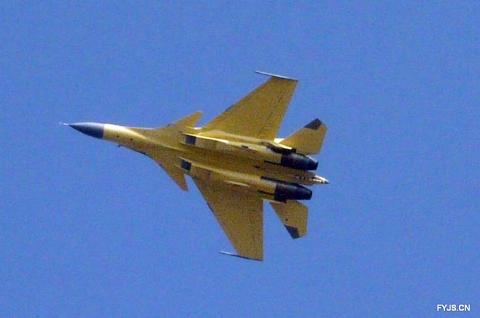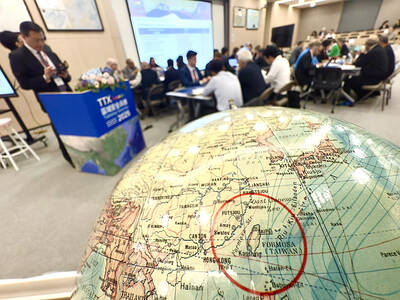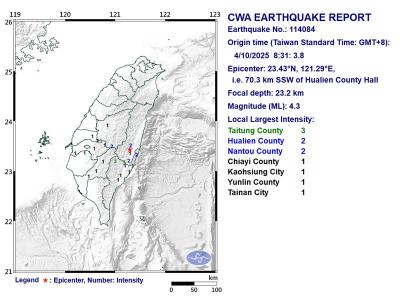Reports last month that China’s first aircraft carrier could embark on its maiden voyage sometime this year, added to speculation that the Chinese navy’s first -carrier-based aircraft could be operational by 2015, point to the high likelihood that Taiwan’s security dilemma is about to become even more complex. That said, Taipei and the region need not panic just yet, analysts say.
After nearly nine years of refurbishing work at a port in Dalian, Chinese military enthusiasts and media say that the People’s Liberation Army Navy’s (PLAN) first aircraft carrier — acquired from Ukraine in 1998 — could set sail as early as this summer.
Although the Varyag, which reports claim will be renamed “Shi Lang,” after a Qing Dynasty admiral, has been officially advertised as a training platform, analysts say that it could also serve combat purposes.

Photo: Lo Tien-pin, Taipei Times
The Varyag still lacks some of its more high-tech features, such as phased array radars and surface-to-air missiles, and those features are unlikely to be fully installed when the carrier sets out on its first journey.
Questions also remain about the engine that will be used to propel it, as the hull acquired in 1998 reportedly did not come with an engine or, if it did, it had been deliberately damaged as the result of foreign political pressure on Kiev.
PLAN pilots also have very little experience with the hazardous takeoffs and landings on an aircraft carrier, and those aircraft — such as the Russian-made Sukhoi-33 and China’s J-15 Flying Shark, which unconfirmed reports claim is nearing completion — have yet to prove their combat effectiveness. All of this means that the Varyag is unlikely to serve as an actual combat platform for a few years.
However, that time will come and unless Taiwan, regional powers and the region’s sole guarantor of security, the US, react accordingly, when that time does come, it has the potential to be a game changer.
When asked by the Taipei Times to comment on what the back-to-back announcements meant for regional security, James Holmes, associate professor of strategy at the US Naval War College, said that the news was expected.
“We’ve known the ship is coming for some time now, so it makes sense they’d be working on an air wing. If the J-15 is indeed fully ready to go by 2015, that will probably coincide with when the ship is fully ready to go,” he said on Wednesday.
Holmes also said there was no need for alarm just yet.
“Having put an old ship — a ship that, unlike the foreign-built, never operational Varyag, was built by my country and had operated successfully at sea — I feel pretty safe in saying it will be a while before the Varyag is fully ready for service,” he said.
“Going out on sea trials is the beginning of the road, not the end,” Holmes said. “Getting all of the ship’s systems in working condition is quite another and that leaves aside the perils of launching and recovering aircraft at sea.”
Toshi Yoshihara, also of the US Naval War College, believes the immediate strategic impact of a Chinese aircraft carrier will be minimal, because the PLAN will need to build a much larger fleet of surface combatants to form the US equivalent of a carrier strike group.
“The Chinese still seem to be engaging in a fleet experimentation process, figuring out what would work best for them,” he said. “The dribs and drabs of multiple ship types that characterize the current fleet won’t really cut it for -serious war-fighting purposes. They still need to settle on a satisfactory ship design, which they seem to be nearing, and proceed with serial production.”
“Then, putting a flotilla together centered around the carrier and integrating the pieces into an organic combat unit will be the next challenge. This will take time,” Yoshihara said, adding that potential PLAN losses and the attendant public relations setbacks as pilots experiment with carrier-based operations would likely compel Beijing to call for a go-slow approach to minimize risks.
Holmes, who recently co--authored a book on the PLAN with Yoshihara, said the assessment that the Varyag would predominantly be used for training purposes appeared to be correct.
Regarding the impact of the Varyag on Taiwan’s security, Holmes said a carrier would certainly impose a new threat axis on Taipei and compel it to think about defending its eastern seas and skies, as well as around the western periphery, a direction it did not have to worry about previously.
“However, Taiwan lies within range of so much land-based PLA [People’s Liberation Army] weaponry and aircraft and so many seagoing assets that a single carrier group would make little difference except at the margins,” he said.
“Over the longer term, as more carriers enter the fleet and PLAN pilots become more proficient, then that might change,” Holmes said.
According to various reports, in addition to the Varyag, China is believed to be building its own nuclear-powered aircraft carriers, some of which could be deployed around 2020. The PLAN has reportedly shown great interest in smaller carriers, such as the French-built Clemenceau-class.
PLAN conventional carriers would likely operate mainly in the South China Sea, helping uphold Beijing’s territorial claims there and continuing to refine carrier operations until nuclear-powered carriers enter the fleet, Holmes said.
“If Beijing goes down that road, nuclear propulsion would liberate the PLAN for operations farther afield, most likely in the Indian Ocean basin, while easing the need for foreign bases somewhat,” he said.
Reports that China may be developing Landing Helicopter Dock vessels, from which vertical and short takeoff and landing (VSTOL) aircraft could operate, would also add to China’s operational capabilities out at sea. Last month, unconfirmed reports claimed China had flight-tested a J-18 Red Eagle multi-role aircraft with VSTOL capabilities.
Of course, what makes an aircraft carrier a potent combat platform at sea is predominantly the aircraft it carries. If reports from earlier last week are true that the J-15 is nearing completion, its entry sometime near 2015 could spell trouble not just for Taiwan, but the region as a whole.
“The big news regarding the J-15 is that when it first deploys, the PLAN’s first aircraft carrier will have a fighter that is competitive-to-superior to the US-made Boeing F/A-18E/F, the expected US Navy workhorse fighter for many years to come,” said Rick Fisher, a senior fellow at the International Assessment and Strategy Center in Washington and an expert on the Chinese military.
The J-15 would also be markedly superior to the aircraft in the Taiwanese air force.
In terms of ordinal performance measures, China’s J-15 and the F/A-18E/F could be about the same, Fisher said. However, when it comes to electronic capabilities — perhaps one of the more important measures in a modern combat environment — the J-15 could soon prove to be uncomfortably competitive, as it will likely also feature an electronically scanned array radar like the latest versions of the F/A-18E/F.
In Fisher’s assessment, the J-15 would also be uncomfortably competitive in terms of the weapons it carries.
“The latest version of the PL-12 air-to-air missile now in PLA service, which is basically comparable to the US Raytheon AIM-120 AMRAAM, employs a dual-mode seeker or the ability to use both active radar and passive seeker guidance,” he said.
Passive seeking allows a missile to home in on a signal, such as that given by a radar or communications device. Additionally, because it uses less electricity, the missile can achieve greater distance.
According to Fisher, the US will not deploy a dual-mode seeker equipped AIM-120 until its next version.
In addition, the PLA could also have a lead in the development of longer-range ramjet powered air-to-air missiles, which may have pushed the US to accelerate work on a similar program, he said.
“On a plane-versus-plane measurement, the US Navy will not be able to automatically guarantee maritime air superiority once the PLAN works up and deploys its first carrier air wings,” he said.
Although the US Navy could -argue that it no longer fights in the traditional way and that therefore weighing one F/A-18E/F against one J-15 misrepresents the actual balance of power in the electronic age, sustained efforts by the PLA to target the US Navy’s networks could quickly undermine that superiority, Fisher said.
If the PLA can defeat electronic support platforms, which is what ostensibly gives the US Navy an edge on the PLAN, “the F/A-18 pilot will be in a lonely fight rather fast,” he said.
As a guarantor of security for Taiwan and a reassuring source of stability in the Asia-Pacific, the US will have to react proactively to the twin introduction of a Chinese aircraft carrier and PLAN combat aircraft or its credibility and ability to maintain peace in the region will suffer, he said.
“If the US Navy does not commit to the development of a combat aircraft with all-around superiority to the J-15, it will be conceding to China a level of strategic risk and uncertainty not seen since the air battles of the Korean War,” Fisher said, adding that the consequences of such strategic concessions would include diminished deterrence of Chinese military aggression and new political doubts about the viability of US military alliance guarantees.

DEFENSE: The National Security Bureau promised to expand communication and intelligence cooperation with global partners and enhance its strategic analytical skills China has not only increased military exercises and “gray zone” tactics against Taiwan this year, but also continues to recruit military personnel for espionage, the National Security Bureau (NSB) said yesterday in a report to the Legislative Yuan. The bureau submitted the report ahead of NSB Director-General Tsai Ming-yen’s (蔡明彥) appearance before the Foreign and National Defense Committee today. Last year, the Chinese People’s Liberation Army (PLA) conducted “Joint Sword-2024A and B” military exercises targeting Taiwan and carried out 40 combat readiness patrols, the bureau said. In addition, Chinese military aircraft entered Taiwan’s airspace 3,070 times last year, up about

A magnitude 4.3 earthquake struck eastern Taiwan's Hualien County at 8:31am today, according to the Central Weather Administration (CWA). The epicenter of the temblor was located in Hualien County, about 70.3 kilometers south southwest of Hualien County Hall, at a depth of 23.2km, according to the administration. There were no immediate reports of damage resulting from the quake. The earthquake's intensity, which gauges the actual effect of a temblor, was highest in Taitung County, where it measured 3 on Taiwan's 7-tier intensity scale. The quake also measured an intensity of 2 in Hualien and Nantou counties, the CWA said.

The Overseas Community Affairs Council (OCAC) yesterday announced a fundraising campaign to support survivors of the magnitude 7.7 earthquake that struck Myanmar on March 28, with two prayer events scheduled in Taipei and Taichung later this week. “While initial rescue operations have concluded [in Myanmar], many survivors are now facing increasingly difficult living conditions,” OCAC Minister Hsu Chia-ching (徐佳青) told a news conference in Taipei. The fundraising campaign, which runs through May 31, is focused on supporting the reconstruction of damaged overseas compatriot schools, assisting students from Myanmar in Taiwan, and providing essential items, such as drinking water, food and medical supplies,

New Party Deputy Secretary-General You Chih-pin (游智彬) this morning went to the National Immigration Agency (NIA) to “turn himself in” after being notified that he had failed to provide proof of having renounced his Chinese household registration. He was one of more than 10,000 naturalized Taiwanese citizens from China who were informed by the NIA that their Taiwanese citizenship might be revoked if they fail to provide the proof in three months, people familiar with the matter said. You said he has proof that he had renounced his Chinese household registration and demanded the NIA provide proof that he still had Chinese